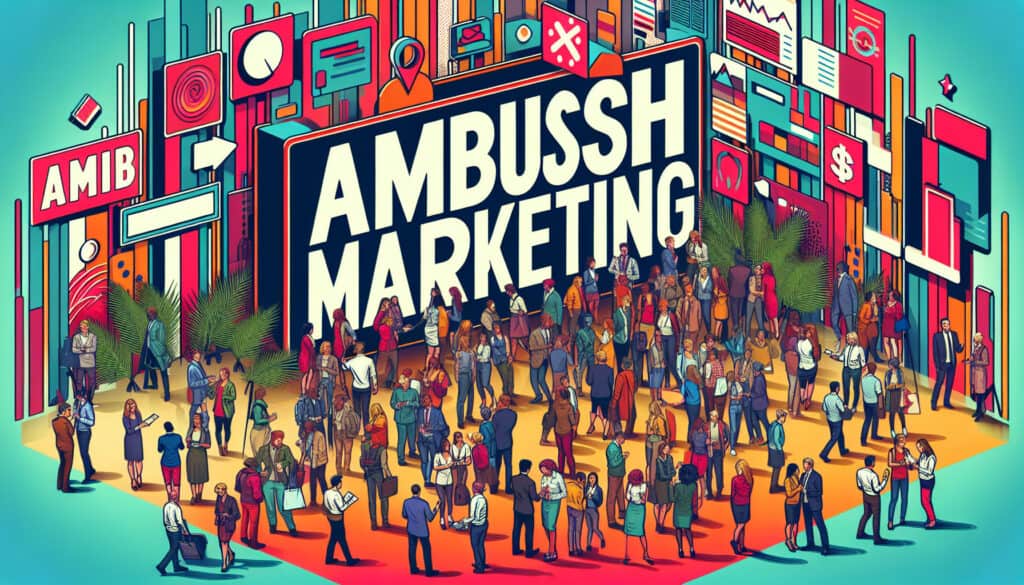A marketing strategy in which a company attempts to associate its products with an event that already has official sponsors.
- Methodologies: Customers & Marketing, Economics, Lean Sigma, Manufacturing, Project Management, Quality
Ambush Marketing

Ambush Marketing
- Brand Positioning, Branding Strategies, Competitive Analysis, Consumer Experience, Customer Experience, Marketing, Marketing Strategy, Product Branding, Product Positioning
Objective:
How it’s used:
- Ambush marketing is used to create the impression that a company is an official sponsor of an event, without having to pay the high sponsorship fees.
Pros
- Can be a cost-effective way to gain brand exposure, can create a buzz around a brand, and can be used to undermine a competitor's sponsorship.
Cons
- Can be seen as unethical, may damage a brand's reputation, and can lead to legal action from the official sponsors.
Categories:
- Customers & Marketing
Best for:
- Gaining brand exposure at a major event without being an official sponsor.
Ambush marketing sees diverse applications across various industries, especially during large-scale events like the Olympics, World Cup, and music festivals, where dominant brands vie for consumer attention. Its implementation typically occurs during the project phases leading up to major marketing events, allowing companies to devise strategies that sidestep traditional sponsorship costs. It can involve creative advertising tactics, such as proximity marketing, where brands advertise near the event location or create themed campaigns that resonate with the event’s essence without formally associating with the organizers. Companies like Nike and Coca-Cola have famously employed ambush marketing, generating significant publicity while remaining competitors to primary sponsors such as Adidas and Pepsi. Successful ambush campaigns often require collaboration among marketing teams, creative agencies, and public relations experts who together engineer innovative promotional materials that instigate consumer engagement. This strategy can also play a psychological game with competitors, as it can diminish the perceived exclusivity of an official sponsor, possibly affecting their brand equity. A key element is ensuring that the ambush tactics do not infringe on legal boundaries, which often involves research into trademark laws and sponsorship agreements to avoid legal repercussions. These methodologies can be particularly beneficial to smaller brands or startups looking to establish a foothold in competitive markets without the hefty investment typical sponsorship entails.
Key steps of this methodology
- Identify a high-profile event relevant to your target audience.
- Develop creative marketing tactics that leverage the event's visibility without direct association or sponsorship.
- Engage with attendees and spectators through strategic positioning within proximity to the event.
- Create compelling content or ads that evoke the event's themes, subtly linking your brand to the experience.
- Utilize social media and digital platforms to amplify your presence and encourage user-generated content related to the event.
- Monitor audience reactions and engagement in real-time, adjusting your tactics as necessary.
- Capitalize on any public relations opportunities arising from your campaign during or after the event.
Pro Tips
- Leverage social media campaigns that connect your brand to the event’s trending topics, increasing visibility without direct association.
- Engage in guerrilla marketing tactics near event venues to spark conversation and create a physical presence that rivals official sponsors.
- Use influencer partnerships to create authentic content associating your brand with the event, circumventing the need for formal sponsorship.
To read and compare several methodologies, we recommend the
> Extensive Methodologies Repository <
together with the 400+ other methodologies.
Your comments on this methodology or additional info are welcome on the comment section below ↓ , so as any engineering-related ideas or links.
Historical Context
1960
1980
1983
1990
1995
2000
2010
1950
1980
1980
1986
1994
1995
2000
(if date is unknown or not relevant, e.g. "fluid mechanics", a rounded estimation of its notable emergence is provided)














Related Posts
Musculoskeletal Discomfort Questionnaires
Multivariate Testing (MVT)
Multiple Regression Analysis
Motion Capture Systems
MoSCoW Method
Mood’s Median Test